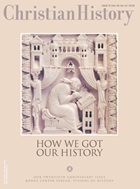The remote monastery at Jarrow, nestled on a spit of land extending into the river Tyne, was only a few years old when the plague hit in 686. Every monk succumbed to the pestilence except Abbot Ceolfrid and a "little lad" who had been made a ward of the monastery. Most scholars identify the "little lad" as Bede. The young survivor, if not yet "venerable," was resilient.
Relatively little else is known of Bede's life. Most direct information we possess derives from Bede's own abbreviated account of his life at the end of his most famous work, the Ecclesiastical History. Beyond the fact that he was a "priest of the monastery of the blessed apostles Peter and Paul at Wearmouth and Jarrow," Bede offers only the following pithy autobiographical fragment:
"I was born on the lands of this monastery, and on reaching seven years of age, I was entrusted by my family first to the most reverend Abbot Benedict and later to Abbot Ceolfrid for my education. I have spent all the remainder of my life in this monastery and devoted myself entirely to the study of the Scriptures."
Based on the date given for the completion of the Ecclesiastical History, Bede was born in 673. He spent his formative years in the cloister at the twin monasteries of Wearmouth and Jarrow, founded by Benedict Biscop in 674 and 681, at the mouth of the two rivers.
In many respects, Bede was a typical monk. Excavations have revealed that he probably lived in a small cell, with much of his day governed by the monastic office—meeting with his fellow monks seven times a day and once a night to sing or read the Scriptures. He saw these meetings as more than just a routine, for he once wrote in a letter, "I know that the angels are present at the canonical Hours, and what if they do not find me among the brethren when they assemble? Will they not say, Where is Bede? Why does he not attend the appointed devotions with his brethren?"
The rest of Bede's day was divided between work and study of Latin, Greek, Roman law, chant, mathematical calculation, and the zodiac. He spent considerable time writing, for in addition to the Ecclesiastical History he penned Old and New Testament commentaries as well as books on grammar, computation, and lives of saints.
One of the great legacies of Biscop was the library at Jarrow, with its biblical texts and commentaries by Augustine, Ambrose, Jerome, and Gregory the Great. Jarrow also contained a Scriptorium, where Bede must have spent many hours copying manuscripts. Educated principally by the Latin Bible, he spent the best part of his life compiling commentaries from the Fathers.
Bede must have been a successful monk, for he was ordained a deacon at the uncanonical age of 19 and later became master of education at Jarrow. "It is always my delight to learn and to teach," he wrote.
Unlike his predecessors, he seems to have traveled rarely, though traveling abbots kept the libraries at the twin monasteries well-stocked. Their finds supplied Bede with important sources for his most famous historical work.
Bede was especially indebted to Eusebius of Caesarea, whose Church History set the standard for all church historians. Bede's aim seems to have been to do for the history of the church in England what Eusebius had done for the universal church.
Molded by Scripture
Like Augustine, Bede saw world history divided into six ages, which correspond to the six days of creation. Each age was marked by a major redemptive-historical person or event: Creation, the Flood, Abraham, David, the captivity of Judah, and the birth of Christ. The Ecclesiastical History is principally concerned with the sixth age, which was inaugurated by the birth of Christ. Therefore Bede employs the distinctively Christian dating system anno Domini (in the year of our Lord).
Bede's first book corresponds to the biblical book of Genesis in its focus on origins of English history. But Bede does not begin with human history. Rather, he begins with a geographic description of "Albion" (the former name of Britain), with its plentiful timber, pasture, birds, fish, and minerals, which has the effect of conjuring up an Edenic vision of an island paradise.
This book peaks with Bede's vivid account of the martyrdom of Alban, a pagan who offered protection to a Christian priest whose piety had deeply impressed him. When imperial soldiers came to arrest the priest, Alban donned the priest's cloak and surrendered himself in his place. Boldly defying his captors, he refused to offer sacrifices to pagan gods and was sentenced to death.
On the way to his execution, several miracles transpired. A river dried up to make a path for them to cross, water miraculously bubbled up from the ground when they were parched, and when the executioner's wicked duty was done, Bede records, "the martyr's head fell, [and] the executioner's eyes dropped out on the ground." These miracles hearken back to the Mosaic miracles in the Pentateuch—the parting of the Red Sea and the water from the rock at Rephidim.
Bede's second book closely parallels the era of the Gospels, recording the establishment of Christianity. Bede pays tribute to Pope Gregory, whom he designates the "apostle" to the English nation. He recounts how Gregory's desire for the salvation of the English was kindled by coming across some fair-skinned slaves being sold in a Roman marketplace. When told they were from the island of Britain and their race called "Angles," Gregory declared: "That is appropriate, for they have angelic faces, and it is right that they should become joint-heirs with the angels in heaven."
After becoming Pope, Gregory sent Augustine of Canterbury to convert the English, and inevitably Augustine's appointment as archbishop establishes the episcopate and a link to the apostolic era.
Books three and four replicate the Acts of the Apostles and Pauline Epistles with their description of the expansion and consolidation of the English church. In book three, Bede gives an account of the growth of the church under Christian kings and describes what he considers the watershed event in the early history of the English church—the Synod of Whitby, which asserted Roman authority over the Celtic churches in such matters as setting the date for Easter.
Book four opens with the story of one of the greatest bishop-saints in the history of the church in England, Theodore of Tarsus, whose reign as Archbishop of Canterbury saw the church of England come of age.
Of the saintly bishops who figured prominently during Theodore's tenure, none was greater than Cuthbert, who ministered both in life and in death. Bede links magnificent miracles to Cuthbert's tomb: a monk is cured of his paralysis, the diseased eye of a young monk is restored after he comes into contact with the "hairs of the holy Cuthbert's head," and Cuthbert's body is found to be without decay when exhumed 11 years after death.
All of these miracles seem to have a New Testament orientation, even a Pauline tone, as when Bede records of Cuthbert's body, "when they opened the grave, they found the body whole and incorrupt as though still living." It would seem that Bede shaped these materials to draw a link with the New Testament church and to display divine approval of the church in England.
Bede's final book reflects the eschatological tone of John's Apocalypse, complete with striking visions of the afterlife. One vision is shared by Drythelm, who was at death's door when a "man in a shining robe" appeared, pulled back the veil of the seventh age, and gave him a guided tour of purgatory.
Reminiscent of Dante, Drythelm observes a two-tiered purgatory, a valley of "burning flames and icy cold" and a "pleasant meadow filled with the scent of flowers." This dramatic portrait of the afterlife clearly parallels the New Testament Apocalypse, with its visions of judgment.
The Apocalypse of John also envisions a glorious harmony in the new heavens and the new earth, an idea captured by Bede in the final chapters of book five. In these chapters unification grows between the English church and the Roman mother church, particularly in the success stories of how dissident churches came to accept the Roman dating of Easter.
Continuing redemption
In Bede's view, English church history continued the story of the New Testament. As he did with the Jews of old and the Gentiles of apostolic times, God was redeeming the English people for himself. Like the biblical writers, Bede recounts the history of that redemption in order to remind the English of what God has done. All history is redemptive history.
As the first great historian of the church in England, Bede belongs to a world very different from our own. For him, history was never purely secular, but a temporal manifestation of the divine plan of redemption. Bede also believed that this divine plan worked through Christian kings and the Roman Catholic hierarchy. Some of Bede's Celtic contemporaries disagreed with these views. Many modern readers, too, find such a pro-establishment bias suspicious or even repressive.
Other critics have judged Bede a "second-rate scholar" because his Ecclesiastical History is largely derived from the works of previous church historians. However, this material has been carefully reshaped by a redemptive historical vision and made theologically coherent so that the sum is greater than its parts. "It takes a kind of genius to do this sort of thing well," judges one modern medievalist—a kind of genius that Bede undeniably possessed.
Frank A. James III is professor of historical theology at Reformed Theological Seminary in Orlando.
Copyright © 2001 by the author or Christianity Today/Christian History magazine.
Click here for reprint information on Christian History.

Support Our Work
Subscribe to CT for less than $4.25/month




























